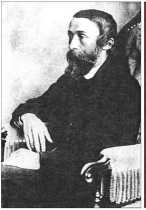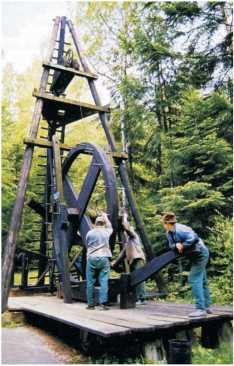869568703
Przegląd Geologiczny, vol. 55, nr 12/1, 2007
Przegląd Geologiczny, vol. 55, nr 12/1, 2007

DLAUTRWALEN1A PAMIĘCI ZAŁOŻONET KOPALNI OLEYU SKALNEGO W BĆBRCE WR nsą JGNACY ŁUKASIEWICZ
i nn ii
Fig. 2. Ignacy Łukasiewicz, the creator Fig. 3. Inscription on the obelisk in Bobrka; funded by , , , , ,
of the Polish and the world petroleum I. Łukasiewicz on the occasionofestablishing the petroleum ®®P'sea ® 0 ,s .7
n 1854 (after Sozański et al, 2002)
industry (after Sozański, 2004)
used in the Lviv municipal hospital during the serious sur-gical operation on 31 July 1853. This datę was accepted as the beginning of world oil industry. In December 1853 Łukasiewicz and Zeh patented in Vienna the method of the oil distillation for getting a liąuid paraffin for kerosene lamps. Six years later, in 1859, Edwin Drakę madę the oil borehole in Titusville in Pennsylvania to the depth of 23 m — in the world petroleum history this datę is very often cited.
Łukasiewicz established the first oil-well in Bobrka (recently there is located the museum of oil and gas industry in Poland), the fact commemorated by the obelisk with the suitable inscription (Fig. 3). Increasing demand for kerosene and lamps grew ąuickly, a petroleum production and export especially to Vienna, Prague and Berlin was impressive. The continued demand for oil resulted in its output increasing and in the exploration development.
First searching and exploitations works
The first petroleum wells were established by Ignacy Łukasiewicz in Bobrka in 1854 (Fig. 4). In the same time the similar “mines of oil” existed in Siary and Sękowa near Gorlice. Also in 1854 a first Street kerosene lamp was swi-tched on by Łukasiewicz in Gorlice.
The first mining holes were the wells dug for depths of 15-60 m, from which petroleum was being drawn with wooden buckets by using gin. When petroleum deliveries were assured, Ignacy Łukasiewicz founded in 1856 the first petroleum distillery in Ulaszowice near Jasło, second one in 1858 in Klęczany, and third one in Polanka near Krosno in 1861. The most modem factory was also built by Łukasiewicz in 1865 in Chorkówka, basing on the raw materiał delivered in wooden barrels from the nearby minę in Bobrka. Products were sold to the petroleum distilleries in Galicia, Vienna, Budapest, Prague and Berlin.
Successes of Łukasiewicz caused that in surroundings of Krosno, Gorlice and Nowy Sącz many smali mines and distilleries were founded. Foreign companies were interested in the oil industry in Galicia and the surname “Łukasiewicz” became well known. Rockefeller was also interested in the development of output and processing of Petroleum industry in Galicia and sent to him his own experts.
In the 1890s in the Carpa-thians new oil deposits were revealed in the Gorlice--Jasło-Sanok region. In 1888 the Bergheim Mac Garvey Company discovered the new oil fields in Węglówka near Krosno and the Galician Oil Mining Company found oil--rich deposits in Potok, Tura-szówka, Iwonicz, Stara Wieś, Rudawka Rymanowska, Wań-kowa. Discoveries were also along the Carpathians thrust front where exists the zonę of
Miocene deposits. Oil fields are here located at depth of 800-2000 m. In this zonę in Borislav vicinity a few very efficient oil and gas fields were documented in 1896, such as Schodnica, Mraźnica and Tustanowice. In 1893 Mac Garvey with help of Władysław Długosz and the driller Jan Rączkowski began the well “Na

Fig. 4. Eąuipment for manuał borehole drilling; Museum of Petroleum Industry in Bobrka (after Garncarski et al, 2001)
1050
Wyszukiwarka
Podobne podstrony:
Przegląd Geologiczny, vol. 55, nr 12/1, 2007 Lublin Region. Lublin region from a petroleum point of
Przegląd Geologiczny, vol. 55, nr 12/1, 2007 Fig. S. Cross-section of the Borislav oil field (by Toł
Przegląd Geologiczny, vol. 55, nr 12/1, 2007 Przegląd Geologiczny, vol. 55, nr 12/1, 2007 9. Profess
Przegląd Geologiczny, vol. 55, nr 12/1, 2007 Fig. 12. Photo of Polish geologists team during the
Przegląd Geologiczny, vol. 55, nr 12/1, 2007 Fig. 13. Schematic map of oil and gas fields in the Car
Przegląd Geologiczny, vol. 55, nr 12/1, 2007 mented from which morę than 100x 109m3ofgasand3.3x 1061
Przegląd Geologiczny, vol. 55, nr 12/1, 2007 Przegląd Geologiczny, vol. 55, nr 12/1, 2007 Fig. 16. P
Przegląd Geologiczny, vol. 55, nr 12/1, 2007 Fig. 17. “Bamówko-Mostno-Buszewo” (BMB) oil-gas field i
Przegląd Geologiczny, vol. 55, nr 12/1, 2007ExpIoration and expIoitation of oil and gas fields in Po
Przegląd Geologiczny, vol. 55, nr 12/1, 2007References BOHDANOWICZ K. 1936 — Niektóre zagadnienia ge
więcej podobnych podstron